光诱捕技术在蚊虫监测中的应用_傅桂明
##蚊虫监测技术概述_王晓中

蚊虫监测技术概述王晓中宋锋林樊德海李建训辽宁出入境检验检疫局(大连,116001)中图分类号R184.31文献标识码B蚊虫的监测有利于了解蚊虫的种类、密度、地理分布、季节消长等规律,对虫媒传染病的预测、预防和风险分析具有重要意义[1,2]。
1成蚊监测技术概述成蚊监测主要用人工叮咬法、人工小时法、诱蚊器收集法、人帐诱捕法、网捕法、目测计数法、肃清计数法、单位面积计算法,以及灭蚊磁场和卫星遥感技术等[3]。
1.1人工叮咬法(人诱叮刺法,人饵诱捕法)人工叮咬法是以三人一组,选择清晨或傍晚时间,在无阳光和避风的场所,三人呈三角形面对面坐好不动,暴露小腿,等蚊子叮咬,然后用捕蚊器或吸蚊管人工捕蚊[4]。
从捕到第一只蚊子算起连续捕捉1h,将捕获的成蚊毒死,鉴定蚊种并计算密度指数[只/(人工·小时)]。
人工叮咬法是对白纹伊蚊成虫最有效的监测方法,但是由于存在监测人员被感染疾病的危险而很少被实际应用,因此国外将白纹伊蚊的监测重点放在幼虫的监测上,采用GIS(Geographic Information System,地理信息系统)监测系统和诱卵器法。
利用人工叮咬法计算叮咬率,可以得出何时发出预警最为合适,对于控制蚊媒密度,控制登革热疫情具有重要意义[5]。
加强蚊媒监测,有针对性地采取控制措施,开展健康教育,采取专业人员督查和群众自觉翻盆倒罐相结合的方法铲除蚊虫孳生地,是阻止登革热卷土重来的有效手段。
1.2人工小时法人工小时法是选择适当的成蚊栖息场所,一个人一个小时内捕获的某一种成蚊数,即为该蚊种的成蚊密度。
将监测收集到的蚊虫带回实验室分类鉴定蚊种,并计算密度,单位为只/人工小时。
人工小时法用于入出境列车白天和夜晚调查车厢内的成蚊种及密度时,在车厢内,调查人用手持电动吸蚊器吸捕成蚊15min,光线不足时可借助手电筒照明[6]。
章士军等对南通市进行蚊种监测鉴定时,采用人工小时法[7,8]。
监测时间为4~11月,每月2次,相邻两次的测定间隔为15d。
城市害虫灯光诱捕技术

城市害虫灯光诱捕技术沈培谊1蒋洪2(1. 杭州市疾控中心;2. 武汉大学基础医学院)利用昆虫趋光性对害虫进行预测预报及防治是农林业植保的重要手段,也是城市害虫防治的重要措施,具有对环境影响小、维护简单的优点,对保护环境十分有利。
诱虫灯的种类非常多, 常用的诱虫光源有电灯、汽灯或油灯, 70年代以来, 黑光灯等新型诱虫灯被广泛应用于害虫的预测预报和防治。
电子技术、太阳能技术等新技术的应用推动了诱虫灯诱虫功能的多元化发展, 出现了如LED 诱虫灯、太阳能诱虫灯等新型节能高效的诱虫灯。
随着社会对环境和健康的关注,可以保护和维持良好的生态环境, 促进人与自然的和谐统一的灯光诱捕害虫技术将越来越多的被专业有害生物管理公司(PMP)在城市害虫防治领域得到广泛应用。
虽然诱虫灯在餐厅、食品加工厂等各种室内环境得到广泛应用,但是缺乏防治效果评测报告和详细的应用指南,现场防治效果难以保证。
本文总结了诱虫灯安装要点、检查程序和现场应用案例,供PMP同行参考。
1 诱虫灯安装要点人居环境用的诱虫灯分为室内用和室外用两种,前者防制侵入室内的飞虫,后者为降低外环境病媒飞虫密度。
1.1 室内型诱虫灯安装位置在大型建筑安装室内型诱虫灯是,首先应设置可以防御外环境飞虫入侵的诱虫灯,一般安装在员工通道、货物进出通道、废弃物运输通道上,迎宾的主通道一般用旋转门或风幕防虫。
在建立完善的防虫设施后,灯光诱捕可作为飞虫防治基本措施应用。
室内区域设置时,应划定飞虫控制最敏感区域,一般包括下列场所:•医院手术室;•急诊区域;•药剂室;•食品加工与包装区域;•商用厨房;•餐饮服务区域;•食品烘焙车间;•食品成品发送区;•零售商店;•谷物仓库;•宠物区;1.2室内型诱虫灯安装要点•将诱虫灯设置在距离入口1.5米至4.5米区域;•幼虫灯的管线对准室内,从外部看不见引诱灯管光线;•诱虫灯外环境设置间距7.5米至15米,诱虫灯设置密度取决于飞虫密度、防治阈值、幼虫灯的辐射区域。
淡色库蚊对3种杀虫剂的敏感度测定

淡色库蚊对3种杀虫剂的敏感度测定
任樟尧;杨天赐;傅桂明
【期刊名称】《中华卫生杀虫药械》
【年(卷),期】2006(12)6
【摘要】目的了解湖州等市现场淡色库蚊种团(以下简称现场品系)对3种杀虫剂
的抗性动态,为合理使用杀虫剂,指导灭蚊工作的深入开展提供依据。
方法药液浸渍法,测定Ⅳ龄期幼虫半数致死浓度。
结果现场品系对高效氯氰菊酯、右旋丙烯菊酯、滴滴涕等3种杀虫剂的抗性倍数依次为:湖州市:2.6、3.3、1.2;加兴市:2.8、3.2、1.3;丽水市:2.2、2.8、1.1;金华市:2.8、2.5、1.4;衢州市:3.0、2.1、1.5;台州市:2.9、3.1、1.6。
结论现场品系对3种杀虫剂均产生了不同程度的抗性,但滴滴涕的抗性
指数接近于正常品系。
【总页数】2页(P476-477)
【关键词】淡色库蚊;杀虫剂;抗性;LC50
【作者】任樟尧;杨天赐;傅桂明
【作者单位】浙江省疾病预防控制中心
【正文语种】中文
【中图分类】R384.1;S482.3
【相关文献】
1.山东济宁市淡色库蚊抗药性的测定及杀虫剂配方的筛选 [J], 江洪涛;王怀位;甄天民;王新国
2.郑州和开封两地区淡色库蚊幼虫对几种杀虫剂的敏感度测定 [J], 孙正;葛凤翔
3.4种杀虫剂对淡色库蚊的抗性测定研究 [J], 顾振国;王海燕;王大力;王信宏
4.上海石化地区淡色库蚊幼虫对五种杀虫剂的敏感度测定 [J], 李汉文;任慧;李开荣;苗明民;杨中清;游寿仙
5.杀虫剂复配对淡色库蚊毒力的测定 [J], 李静
因版权原因,仅展示原文概要,查看原文内容请购买。
关于灯光诱虫及其专用设备问题的研究和建议
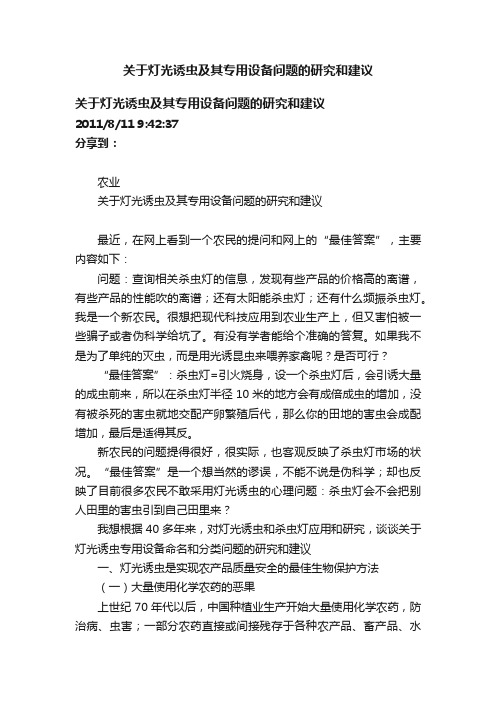
关于灯光诱虫及其专用设备问题的研究和建议关于灯光诱虫及其专用设备问题的研究和建议2011/8/11 9:42:37分享到:农业关于灯光诱虫及其专用设备问题的研究和建议最近,在网上看到一个农民的提问和网上的“最佳答案”,主要内容如下:问题:查询相关杀虫灯的信息,发现有些产品的价格高的离谱,有些产品的性能吹的离谱;还有太阳能杀虫灯;还有什么频振杀虫灯。
我是一个新农民。
很想把现代科技应用到农业生产上,但又害怕被一些骗子或者伪科学给坑了。
有没有学者能给个准确的答复。
如果我不是为了单纯的灭虫,而是用光诱昆虫来喂养家禽呢?是否可行?“最佳答案”:杀虫灯=引火烧身,设一个杀虫灯后,会引诱大量的成虫前来,所以在杀虫灯半径10米的地方会有成倍成虫的增加,没有被杀死的害虫就地交配产卵繁殖后代,那么你的田地的害虫会成配增加,最后是适得其反。
新农民的问题提得很好,很实际,也客观反映了杀虫灯市场的状况。
“最佳答案”是一个想当然的谬误,不能不说是伪科学;却也反映了目前很多农民不敢采用灯光诱虫的心理问题:杀虫灯会不会把别人田里的害虫引到自己田里来?我想根据40多年来,对灯光诱虫和杀虫灯应用和研究,谈谈关于灯光诱虫专用设备命名和分类问题的研究和建议一、灯光诱虫是实现农产品质量安全的最佳生物保护方法(一)大量使用化学农药的恶果上世纪70年代以后,中国种植业生产开始大量使用化学农药,防治病、虫害;一部分农药直接或间接残存于各种农产品、畜产品、水产品以及土壤和水体中,造成农药残留。
高毒农药残留的农产品、食品会导致人、畜急性中毒,毒韭菜、毒豇豆;食用农药残留超标的农副产品,虽然不会出现急性中毒症状,但长期食用会引起人和动物的慢性中毒,导致疾病的发生,甚至影响到下一代;中国农产品质量安全水平落后于发达国家,农产品出口因农药残留及其它有毒有害物质超标问题履遭禁运,农产品出口因质量安全问题每年经济损失十多亿元。
而且,化学防治耗费石化能源,并已经造成了农村环境严重污染。
光催化捕蚊灯工作原理

光催化捕蚊灯工作原理
光催化捕蚊灯利用光催化材料的能力吸引并杀灭蚊虫。
该设备包括一种具有光催化材料涂层的光源,通常是紫外线荧光灯,以及一个吸引装置和杀灭装置。
工作原理如下:
1. 光源:紫外线荧光灯是最常用的光源。
它发出一种被蚊虫视为特别吸引的紫外线光线。
2. 光催化材料涂层:光源表面涂覆了一层光催化材料。
这种材料通常是二氧化钛(TiO2)或其他半导体材料。
当紫外线光线照射在光催化材料上时,它会产生一种被称为光生电子和光生空穴的活性氧化剂。
3. 吸引装置:光催化材料产生的活性氧化剂会吸引蚊虫,因为一些蚊虫对这些氧化剂具有感应性。
一般来说,蚊虫视觉和化学感受器官会被这些活性氧化剂吸引。
4. 杀灭装置:捕蚊灯通常包括一个电网或粘性纸板。
一旦蚊虫被吸引到灯光周围,它们会触碰到电网或陷入粘性纸板中,从而被杀死或被粘住。
总的来说,光催化捕蚊灯的原理是利用光催化材料产生的活性氧化剂吸引和杀灭蚊虫,以达到防止蚊虫侵扰的目的。
白光灯诱捕法
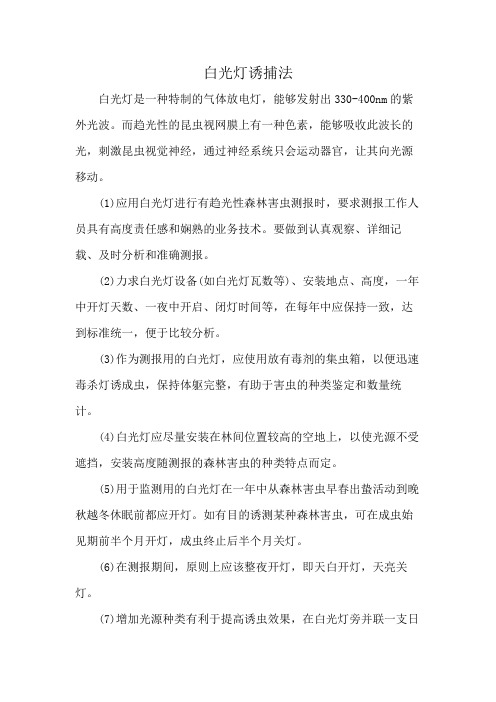
白光灯诱捕法白光灯是一种特制的气体放电灯,能够发射出330-400nm的紫外光波。
而趋光性的昆虫视网膜上有一种色素,能够吸收此波长的光,刺激昆虫视觉神经,通过神经系统只会运动器官,让其向光源移动。
(1)应用白光灯进行有趋光性森林害虫测报时,要求测报工作人员具有高度责任感和娴熟的业务技术。
要做到认真观察、详细记载、及时分析和准确测报。
(2)力求白光灯设备(如白光灯瓦数等)、安装地点、高度,一年中开灯天数、一夜中开启、闭灯时间等,在每年中应保持一致,达到标准统一,便于比较分析。
(3)作为测报用的白光灯,应使用放有毒剂的集虫箱,以便迅速毒杀灯诱成虫,保持体躯完整,有助于害虫的种类鉴定和数量统计。
(4)白光灯应尽量安装在林间位置较高的空地上,以使光源不受遮挡,安装高度随测报的森林害虫的种类特点而定。
(5)用于监测用的白光灯在一年中从森林害虫早春出蛰活动到晚秋越冬休眠前都应开灯。
如有目的诱测某种森林害虫,可在成虫始见期前半个月开灯,成虫终止后半个月关灯。
(6)在测报期间,原则上应该整夜开灯,即天白开灯,天亮关灯。
(7)增加光源种类有利于提高诱虫效果,在白光灯旁并联一支日光灯或白炽灯,诱虫效果可增加数倍,同时,如果在白光灯的四周,加安四块相互交叉的透明玻璃做成的挡虫板,也能使诱虫量增加一倍以上。
(8)开灯次晨将诱获的森林害虫分类整理统计后,应分别把原始数据填入白光灯诱测森林害虫的调查表中。
(9)要加强对白光灯的管理和维护,防止电路失修、灯管损坏、集虫箱毒剂漏散等情况的发生,以免对人畜造成触电、中毒等事故。
同时,还要注意因灯诱引来的害虫集中产卵而造成的灯诱地点的害虫种群数量的剧增,对此,要及时予以消灭。
自动虫情测报灯在林果害虫防治中的应用

自动虫情测报灯在林果害虫防治中的应用应用自动虫情测报灯进行森林害虫和果园害虫灯光诱测,共诱捕到10目26科46种11 575头昆虫,林业害虫中鳞翅目占总虫量的728%,鞘翅目占总虫量的2345%。
虫情测报灯诱测害虫种类多,数量大,诱集益虫数量极少,可作为一种有效的监测、诱杀工具应用于林果害虫的测报与防治工作。
关键词:虫情测报灯;林果害虫;预测预报;防治2012-10-29为了更好地掌握主要林果害虫发生种类、发生期和种群数量动态规律,提高测报准确率和预测预报水平,指导科学防控工作,作者于2012年5月11日至8月31日利用自动虫情测报灯开展了灯光诱测工作。
1材料与方法11供试材料佳多牌JDAO-III型自动虫情测报灯,由河南汤阴佳多科工贸有限责任公司生产。
12设置地点及周围环境虫情测报灯设置在红塔山保护区管理局办公楼顶,距城5 km,海拔1 720m,东面是云南松林,附近有保护区果园、农户养殖场、苗圃,办公区有榕树、滇润楠、石楠、侧柏、雪松、栾树、黄连木、红豆杉等多种园林绿化树种及各种花卉。
13方法自动虫情测报灯是根据黑光灯诱虫原理,集光、电数控技术于一体的新型测报工具,具有光控和雨控功能,在接通电源后,只要是没有下雨,每天晩上天黑便自动开灯,到第二天早上天亮后自动关灯。
如遇下雨会自动关闭接虫口,防止雨水进入灯箱。
测报灯启动后,同时红外线自动杀虫仓启动,成虫因灯光引诱飞向灯管撞到透明玻璃挡板落入红外线杀虫仓。
杀虫仓下面设有8个接虫袋,接虫袋悬挂基座每24 h自动转动一格,诱捕到的成虫会落入1个接虫袋中,每晚诱杀的成虫分别落入不同的袋中,每周取下接虫袋观察记录一次,详细记录每天诱杀的虫种和虫体数量。
8个接虫袋,每星期一9∶00打开杀虫灯接虫箱门,逐个取下接虫袋,鉴定各类昆虫,统计数量,收集完整的成虫制作成标本。
2结果与分析21灯诱林果昆虫的种类和数量通过113 d的自动虫情测报灯监测,共诱集到10目26科46种、11 575头昆虫(含未鉴定的虫种),其中林业的虫种有3目14科24种2 214头,数量占1912%,果园、苗圃的虫种有7目18科23种,数量占2724%;益虫4目4科6种140头,数量占121%,种类占1304%;诱集的益害昆虫比为1∶8267,益害种类数比为1∶767(表1)。
光诱技术在害虫治理中的应用

( 州大学 昆虫 研究所 , 州 山地农 业病 虫害重 点实 验室 , 贵 贵 贵州 贵 阳 502 ) 505
摘 要: 随着害虫综合治理水平的不断提 高, 光诱技术应用越 来越广泛。本 文简要介绍 了光对 昆虫的生态效应和
光诱 技 术的 原 理 , 着重讲 述 了光 诱技 术在 害 虫综 合 防 治 中 的应 用情 况 , 出 了其优 点 和 不 足 , 望 了光 诱 技 术 在 指 展
光 源的光 谱组 成 对 昆虫 趋 光 聚 集 行为 有 很 大 的影 响。D f ua y观察 了夜蛾科 ( otia ) 害虫 N c de 8种 u 的趋光行 为 , 现不 同种类 对 波 长 的要求 不 一 致 , 发 在 相 同波长光 下 , 同的夜 蛾 聚集度 不 同 ; 不 同样 , 同 种 夜蛾对 不 同波长 的光 的聚集 度 也 不 同 J ge 。A e 用 电生理 的方 法 发 现 , 洲 棉 铃虫 Hlivraza 美 e c e e o p
作者简介 : 曹 字( 94一) 18 ,男 ,四川 自贡人 , 硕士研究生。研究方向 : 昆虫生态与害虫监测调控 。 通讯作者 : 郅军锐。E—ma :rh@yho cr.n i j i ao.o c l z n
山 地 农 业 物 学 报 生
3 ( ) 14~19 2 1 1 2 :7 7 ,02
Ju n l o Mo n an Ag u t r a d Bil g o r a f u ti dc lu e n oo y
・
文 献 综 述
・
光诱 技 术在 害 虫治 理 中的应 用 术
6 6 m 起干扰 作用 。 因此 , 5n 通过研 究不 同波长对 昆
物理防治病虫害虫灯光诱杀技术取得的进展及对食品安全与环境安全的贡献

物理防治病虫害虫灯光诱杀技术取得的进展及对食品安全与环境安全的贡献赵树英(河南佳多科工贸有限公司)在1975年来全国植物保护工作会议上,确定“预防为主,综合防治”为我国的植保工作方针;在1994年国家又进一步明确:在可持续农业的发展中,有害生物的可持续管理控制,是必不可缺少的环节,它与环境质量、物种多样性、资源管理和人类的健康都有密切的关系。
国际社会对有害生物的综合治理高度重视,世界范围内正在减少对化学农药的依赖,推动有害生物综合防治,包含物理防治在内,向生态自然调控方向发展。
1在农产品生产过程中病虫害的物理防治方法物理防治病虫害技术主要是利用各种物理因子如光、电、色、波、超声、温度等配合机械设备破坏有害生物的生存环境,干扰其正常活动,最终达到控制和减少有害生物为害农产品的目的。
包括捕捉法、诱集法、声控法、阻隔法,高、低温法,气调法、辐射法和微波法等,既简单易行又行之有效,具有使用范围广,作用特殊,能杀死隐蔽为害的昆虫,对环境无污染,成本低,不破坏生态平衡等特点随着科技发展和社会进步,人们已普遍开始意识到农药对人类健康、食品安全性、环境的负面影响。
国际社会迫切需要的将不再仅仅是更多的食物,而是更高质量的食物和环境。
在这一历史背景下,佳多公司在1986年成立了紫外线应用技术研究所,研究紫外光对生物不同生长时期的影响,总结整理出紫外线对昆虫的生活习性物理作用的基础资料。
20世纪90年代初,佳多公司成立了物理治虫研究所,倡导“农林生物物理工程”,该工程是农业、林业、生物物理工程(生物学、物理学)与工程技术交叉的又一边缘学科。
其研究生物物理学、光声光热效应的农业应用、农业生物物理技术、电磁辐射物理技术、植物细胞信号传导技术生物芯片及其农业应用技术、农业中的电子监控技术、农业信息化技术等。
2物理防治病虫害技术的发展从“飞蛾扑火”的自然现象人们受到启发,光可以引诱飞蛾,至此开辟了人类历史上防治害虫手段的新篇章。
蚊虫对光波段-概述说明以及解释
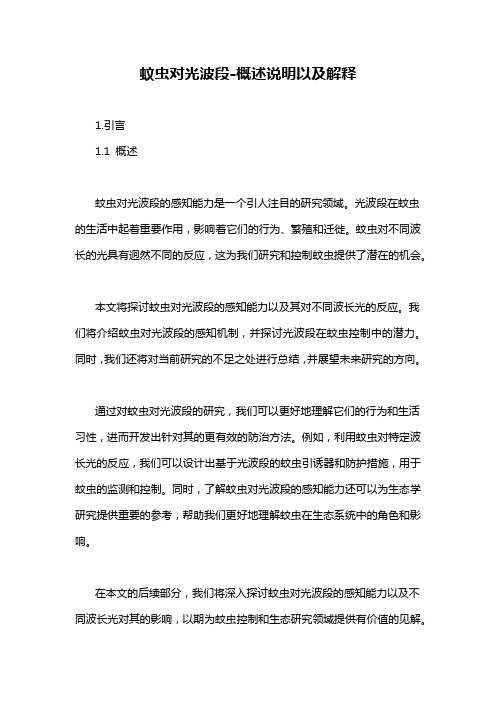
蚊虫对光波段-概述说明以及解释1.引言1.1 概述蚊虫对光波段的感知能力是一个引人注目的研究领域。
光波段在蚊虫的生活中起着重要作用,影响着它们的行为、繁殖和迁徙。
蚊虫对不同波长的光具有迥然不同的反应,这为我们研究和控制蚊虫提供了潜在的机会。
本文将探讨蚊虫对光波段的感知能力以及其对不同波长光的反应。
我们将介绍蚊虫对光波段的感知机制,并探讨光波段在蚊虫控制中的潜力。
同时,我们还将对当前研究的不足之处进行总结,并展望未来研究的方向。
通过对蚊虫对光波段的研究,我们可以更好地理解它们的行为和生活习性,进而开发出针对其的更有效的防治方法。
例如,利用蚊虫对特定波长光的反应,我们可以设计出基于光波段的蚊虫引诱器和防护措施,用于蚊虫的监测和控制。
同时,了解蚊虫对光波段的感知能力还可以为生态学研究提供重要的参考,帮助我们更好地理解蚊虫在生态系统中的角色和影响。
在本文的后续部分,我们将深入探讨蚊虫对光波段的感知能力以及不同波长光对其的影响,以期为蚊虫控制和生态研究领域提供有价值的见解。
通过深入研究蚊虫的光感知能力,我们可以为蚊虫的有效管理和控制提供更全面的解决方案,并为未来的研究提供新的思路和方向。
1.2 文章结构文章结构部分的内容可以按照以下方式进行编写:文章结构本文将按照以下结构进行展开,以深入探讨蚊虫对光波段的感知能力以及光波段在蚊虫控制中的应用。
具体结构如下:引言在引言部分,我们将对本文所要讨论的主题进行概述,并阐述文章的目的和意义。
首先,我们将简要介绍蚊虫对光波段的感知能力,这对于了解它们在不同波长的光下的反应至关重要。
其次,我们将探讨光波段在蚊虫控制中的应用潜力,以及对未来研究方向的展望。
正文正文部分将分为三个小节,分别探讨蚊虫对光波段的感知能力、蚊虫对不同波长的光的反应以及光波段在蚊虫控制中的应用。
首先,我们将详细研究蚊虫对光波段的感知能力,包括它们对不同波长的光的敏感程度和鉴别能力。
接着,我们将探讨蚊虫对不同波长的光的反应,探究它们对光的偏好和避光行为。
浅析灯光诱杀在林业虫害防治中的应用

2015年8月防 护 林 科 技A u g.,2015第8期(总143期)P r o t e c t i o nF o r e s t S c i e n c e a n dT e c h n o l o g yN o .8(S u m N o .143)文章编号:1005-5215(2015)08-0058-02收稿日期:2015-05-05作者简介:关丽萍(1984-),女,黑龙江拜泉人,大学,工程师,主要从事农药剂型加工及农药分析研究.浅析灯光诱杀在林业虫害防治中的应用关丽萍,卢洪斌,胡明慧(黑龙江省平山林业制药厂,黑龙江哈尔滨150324)摘 要 灯光诱杀是林业虫害防治中物理机械防治技术之一㊂文章分析了黑光灯的诱杀原理和装置,总结了各种诱虫灯的使用与实践,阐明灯光诱杀害虫是一项重要的农林业有害生物无公害防治技术,在虫情监测和科研方面发挥了很大作用㊂关键词 林业虫害防治;灯光诱杀;黑光灯;装置中图分类号:S 769 文献标识码:A d o i :10.13601/j.i s s n .1005-5215.2015.08.021A p p l i c a t i o no fL i g h t T r a p p i n g i nC o n t r o l l i n g F o r e s t r y Pe s t s G u a nL i p i n g ,L uH o n g b i n ,H u M i n gh u i (H e i l o n g j i a n g P i n g s h a nF o r e s t r y P h a r m a c e u t i c a l F a c t o r y,H a r b i n150324,C h i n a )A b s t r a c t L i g h t t r a p p i n g i s o n e o f t h e p h y s i c a l a n d m e c h a n i c a l c o n t r o l t e c h n i q u e s a m o n g f o r e s t r ype s t c o n t r o l .T h e p a p e r a n a l y z e s t h e p r i n c i p l e s a n dm e a n s of b l a c k l igh t b o o b y t r a p s ,a n d s u mm a ri z e s t h e u s e a n d p r a c t i c e o f t h e v a r i -o u s t r a p l a m p ,w h i c hc l a r i f i e s t h a t t h e l i g h t t r a p p i n g o n p e s t s i s a n i m p o r t a n t n o n -p o l l u t i o n t e c h n i q u e s f o r c o n t r o l -l i n g a g r o -f o r e s t r yp e s t s ,a n d p l a y s ab i g r o l e i n i n s e c tm o n i t o r i n g a n d r e s e a r c h .K e y wo r d s f o r e s t r yp e s t c o n t r o l ;l i g h t t r a p p i n g ;b l a c k l i g h t ;m e a n s 灯光诱杀是林业虫害防治中物理机械防治技术之一㊂该技术利用害虫的趋光性,设置诱虫器械或其他诱物,诱集捕杀害虫㊂昆虫中的蛾类㊁半翅目㊁鞘翅目㊁直翅目㊁同翅目害虫,大都具有趋光性,设置诱虫灯,可捕杀害虫㊂尤其在虫情监测方面发挥了很大作用,诱捕虫种10余目100多科近300种,以鳞翅目害虫居多㊂1 研究概况我国农㊁林业使用灯光诱捕害虫已有悠久历史,采用的光源,从火把㊁油灯㊁汽灯㊁电灯到黑光灯㊁高压电网和新式频振杀虫灯㊂黑光灯和高压电网在农㊁林业虫害防治中已被大范围推广使用,应用效果良好㊂20世纪50年代,灯光诱杀技术采用的是普通的照明灯具,甚至用煤油或火把;60年代,普遍采用20~40W 黑光灯;70年代光源采用高压汞灯;21世纪初,陆续出现新式的频振杀虫灯㊂林业生产防治中常见的使用普通黑光灯㊁金属卤素灯和高压电网杀虫灯㊂这些灯结构上基本相同,由灯管及其配件㊁防雨罩㊁挡虫板㊁集虫器和支架等组成㊂黑光灯是一种特制的气体放电灯,它能发出330~400n m 的紫外光波,它是人类不敏感光㊂近代科学的发展,研究了昆虫的视觉神经,发现多种农㊁林业害虫对不同波长的光敏感程度不同㊂这是由于这些昆虫眼睛的网膜上有一种色素,这种色素只吸收一种特殊波长的光,然后引起光反应,刺激视觉神经,通过神经系统影响运动器官,从而引起足或翅的运动,飞向光源㊂昆虫对频率越低的光线,感觉是麻木的,而对频率越高的光线,感觉特别敏感㊂许多害虫的视觉神经,都对波长在330~400n m 的紫外线特别敏感,具有最大的趋光性㊂黑光灯恰是一种能发出波长在360n m 左右的紫外线光源,因而诱杀效果好㊂随着科技的发展灯光诱杀技术日渐成熟,灯具已从普通的白炽灯发展到现今的交流电频振式㊁直流电频振式㊁太阳能电频振式杀虫灯㊂2 材料与方法2.1 黑光灯的材料与安装黑光灯灯管:由灯丝㊁管内气体㊁荧光粉和管壁几部分组成㊂配件包括镇流器㊁继电器和开关㊂目前,生产的黑光灯管,由于供电方式不同分为交流黑光灯和直流晶体管黑光灯两类㊂前者用220V的交流电源,光亮度较高,诱杀效果好,但受光源㊁电杆㊁电线的限制;后者用6~12V蓄电池或干电池直流电源,虽然光亮度低些,但使用灵活,可在远离交流电源的地方设灯,使用安全㊂可因地制宜,交直流互相配合选择使用㊂防雨罩:罩在灯管的上端,用来保护灯管及其配件和防止漏电㊂防雨罩用铁皮制成㊂挡虫板:可使害虫扑灯时,较易掉入收集器中,增集效果㊂挡虫板可用铁皮或玻璃片制成,长度与灯管相同,由2~4片组成㊂收集器:装在灯管的下端,用来收集诱来的害虫,如以消灭害虫为主,在集虫漏斗下,用铁纱笼㊁铁筒㊁瓷盆等容器收集;如以采集标本为主,即用毒瓶收集㊂灯架:用木制或铁制三角做成,用来固定黑光灯的各种设备㊂2.2试验方法安装黑光灯时要考虑安全㊁经济㊁简便的原则㊂设置高度一般1~3m为宜,把安装好的黑光灯每200m放置一个,夜间诱捕,天黑开始观测,测出最佳诱捕时间,黑光灯使用时闷热无风的夜晚诱集的种类和数量多,而在风天(4m s-1以上)㊁雨天和气温骤然下降的情况下,诱集的种类和数量显著减少㊂一夜中以19:00 21:00诱集量最大,21:00以后逐渐减少,22:00 24:00的诱集量更少[1]㊂在大面积防治中,零点后关灯,既节省用电,又能达到预期效果㊂防治时分组轮流捕捞成虫,把捞出成虫装袋收集,并做好雌雄比记录㊂在使用黑光灯时应注意所诱集的害虫种类㊁性别和雌虫是否已产卵,明确黑光灯对防治对象是否适用,不同的害虫对黑光灯趋光性程度也不同,同一种害虫不同性别对黑光灯的敏感性也不一样㊂例如:铜绿金龟雌成虫趋光强烈,雄成虫则不趋光㊂大黑金龟则雄成虫趋光,雌成虫不趋光㊂在害虫种类单一的地区,可根据成虫出现的时期,确定设灯诱杀的时间;在害虫种类繁多的地区,一般5 9月为设灯时间㊂梁细弟等灯光诱杀松墨天牛的对比试验研究中[2],灯距为80~120m,一般情况可根据灯管功率的大小适当加大或减少间隔的距离,同时布点要均匀,提高防效㊂2000年闫志利等在试验中用3种诱虫灯对美国白蛾进行诱杀试验[3],1000W诱捕点击灭蛾灯有效照射半径1200m,日平均可诱蛾81.9只;30W频振式杀虫灯有效照射半径200m,日平均可诱蛾47.6只;250W昆虫诱捕器有效照射半径1000m,日平均可诱蛾38.7只㊂挂灯的高度没有统一标准,一般以操作者能达到的高度为宜,即1.5m㊂乔秀荣等于2002年用频振式光控杀虫灯进行诱杀试验时[4],对不同高度进行了试验㊂表1不同高度灯诱情况统计设灯地点设灯高度/m诱虫数量/只1.04139渤海林场1.556942.042681.015410海滨林场2.0105803.09859从表1中可见,灯高1.5m时,诱杀效果最好㊂如果在空旷地布灯,灯高可适当降低㊂尹奉谆等对春尺蠖防治研究证明[5],由于雄蛾多集中在2m内的树干表皮上求偶交配,因此布灯高度以2m为宜㊂3效果分析3.1根据统计,灯光诱杀技术可诱集15目100多科300多种昆虫,其中多数是农林业害虫(益虫的比例不到5%)㊂3.2能消灭大量的有效虫源:诱杀雌虫的比例较大,且大部分未产卵(消灭一只雌蛾就等于消灭上千条幼虫),能达到降低下代虫口密度(降低落卵率85%,降低虫口密度80%)的显著效果㊂3.3诱集面积大㊁成本低:一个20W的黑光灯,最低诱集半径以200m计算,有效诱集面积最低可控制在12h m2左右㊂黑光灯的用电量仅为普通电灯的1/4㊂新式频振杀虫灯每盏可控制的面积近3.3 h m2,一晚的电量费用只为0.17元(按0.70元/度计算)㊂3.4用于预测预报和科学试验的依据:除用于直接灭虫外,还可进行害虫种类㊁分布㊁虫口密度和部分生活史的调查㊂4结论与讨论灯光诱杀是一项重要的农林有害生物无公害防治技术㊂该技术操作简便,并能有效地杀死害虫,显著降低林间㊁田间虫卵量和虫口基数,减少农药使用量,节本增效;同时避免了大量使用农药造成对环境的污染和对天敌的杀伤,不会引起人畜中毒;还有诱捕到的害虫没有受农药污染,含有高蛋白和鱼类生长发育所必需的微量元素,可作为养殖鱼类的优质天然饲料㊂可根据灯光诱杀有趋光性害虫的日期㊁数量㊁雌雄性比㊁雌成虫的遗腹卵数等进行害虫种类调查㊁发生范围测报㊁分布区分析㊁(下转第64页)95第8期关丽萍等浅析灯光诱杀在林业虫害防治中的应用日光温度为白天22ʃ3ħ,夜间15ʃ1ħ㊂超过30ħ或低于5ħ均会对其正常生长发育造成不良影响㊂基质温度控制在18ħ左右㊂每天光照时数保证6h以上㊂2.5修剪技术2.5.1摘蕾为了塑造树势,需要对定植后的小苗进行摘蕾处理,即除去抽芽时形成的花蕾,集中养分优势保障枝干的发育㊂2.5.2疏蕾为了提高产花的观赏价值和经济价值,需进行疏蕾处理,存优汰劣,将紫皇后玫瑰及红袖月季两侧的其他副蕾摘除㊂2.5.3剪枝条捡去病虫害㊁枯死及纤弱枝条,剪去影响观赏的交叉重叠㊁过长或砧木上的萌蘖枝条㊂2.5.4控制开花期为了保证紫皇后玫瑰及红袖月季能够在每年的2月14日(情人节)进行产花销售,需调节控制两者的开花时间㊂一般而言,温室无土栽培要比露地种植提前约20d进行剪枝留芽处理㊂2.6采收技术2.6.1采收利用专业的玫瑰剪采剪紫皇后玫瑰及红袖月季花枝,一般为60~80c m,采剪时间以花瓣最外层2~3瓣外翻时为宜㊂2.6.2采后处理采剪后的花枝容易失水萎蔫,因此,应立即将花梗基部浸于水中,同时调节室温至5ħ左右,使其充分吸水,以便进一步的分级㊁运输㊂分级时除保留叶片3~8片外,应除去多余的叶和刺,然后将其码放于铺有草帘的地面上,按照品种㊁品质及花色进行筛选分类,捆扎成束(每束10枝或20枝),并用质地柔软的包装纸保护好花头,方便运输㊂2.7主要病虫害及防治温室无土栽培的紫皇后玫瑰及红袖月季的病虫害主要以下几种(见表3)㊂表3病㊁虫害种类及防治措施病㊁虫害种类危害部位防治措施白粉病叶片㊁叶柄㊁茎 1.百菌清烟剂熏蒸2.百菌清㊁甲基托布津㊁40%的多菌灵硫悬浮剂500倍液喷雾霜霉病叶片㊁花梗㊁茎 1.百菌清烟剂㊁烟熏王熏蒸2.杜邦克露500倍液㊁普力克700倍液㊁安克锰锌700倍液喷雾红蜘蛛叶片 1.虫螨光3000倍液㊁扫螨净1000倍液喷雾蚜虫叶片 1.敌敌畏烟剂㊁灭蚜烟剂熏蒸2.蚜虱净1000倍液㊁菊酯类农药3000~4000倍喷雾白粉虱叶片 1.灭虱烟剂熏蒸(每隔1周熏蒸1次)3结论与讨论紫皇后玫瑰㊁红袖月季切花的观赏价值及经济价值很高,对其引种栽培也遍布世界各地㊂通过对紫皇后玫瑰及红袖月季在闽南地区温室无土栽培引种驯化技术的探索研究,既可避免由于土壤连作而引起花卉的多种病㊁虫害,又可显著提高名贵花卉切花品质和提早其开花期,对实现现代花卉种植培育技术理论的完善有重要作用㊂福建省人多地少㊁土地资源稀缺,发展设施农业,尤其是发展设施花卉对实现我省有限耕地资源的利益最大化,加快推进现代农业发展具有重要意义㊂参考文献:[1]王多宁.玫瑰花的综合利用及开发前景[J].黑龙江农业科学, 2010(1):117-120[2]余峰.玫瑰精油的提取㊁分析与应用研究[D].南昌大学,2011[3]熊家远,冯文志,王明辉,等.四川省遂宁市月季引种适应性及抗逆性研究[J].园艺与种苗,2012(2):36-38[4]林桂玉,李美芹,吕金浮,等.藤本月季紫皇后组织培养技术[J].江苏农业科学,2014(9):56-58(上接第59页)发生期测报㊁发生量测报㊁种群消长趋势与演变规律预测㊁综合防治效果监测等㊂值得重视的是光灯诱集的害虫,大部分都进入收集器具,但有一部分害虫停落在附近的林地上,造成灯下或设灯附近林地的虫口密度增加,容易造成林木受害,应在设灯附近的林地上,采取其他的防治措施加以补救,保证灯光诱杀的防治效果㊂参考文献:[1]彭涛.黑光灯诱捕昆虫养鱼技术[J].农村实用技术,2000(6):36-37[2]梁细弟,蒋平,周连山,等.灯光诱杀松墨天牛的效果及评价[J].森林病虫通讯,2000(4):28-30[3]闫志利,赵成民,吴焕增,等.3种诱虫灯对美国白蛾成虫诱杀力的比较[J].河北林业科技,2000(5):15-16[4]乔秀荣,韩义生.佳多频振式杀虫灯诱虫情况分析[J].中国森林病虫,2002,21(S1):32-34[5]尹奉谆,秦利芳,余虹丽.春尺蠖羽化监测及防治措施的探讨[J].新疆农业科学,2004,41(5):385-38746防护林科技2015年。
伊蚊诱卵器在伊蚊监测中的应用_周毅彬
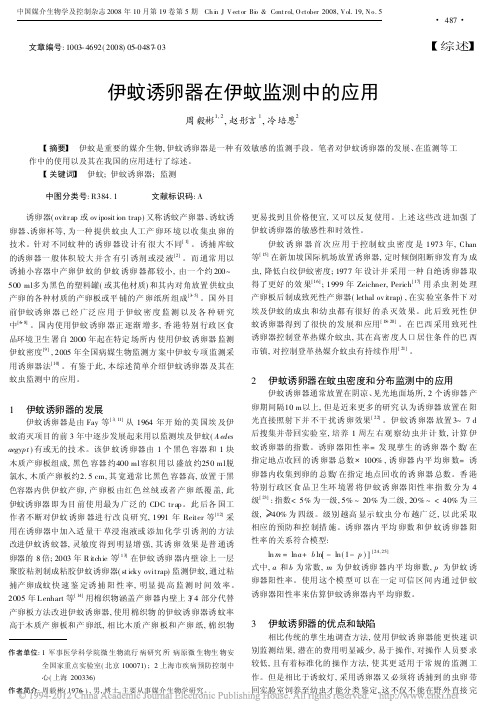
文章编号:1003-4692(2008)05-0487-03=综述>伊蚊诱卵器在伊蚊监测中的应用周毅彬1,2,赵彤言1,冷培恩2=摘要>伊蚊是重要的媒介生物,伊蚊诱卵器是一种有效敏感的监测手段。
笔者对伊蚊诱卵器的发展、在监测等工作中的使用以及其在我国的应用进行了综述。
=关键词>伊蚊;伊蚊诱卵器;监测中图分类号:R384.1文献标识码:A诱卵器(ovitr ap或ov iposit ion trap)又称诱蚊产卵器、诱蚊诱卵器、诱卵杯等,为一种提供蚊虫人工产卵环境以收集虫卵的技术。
针对不同蚊种的诱卵器设计有很大不同[1]。
诱捕库蚊的诱卵器一般体积较大并含有引诱剂或浸液[2]。
而通常用以诱捕小容器中产卵伊蚊的伊蚊诱卵器都较小,由一个约200~ 500ml多为黑色的塑料罐(或其他材质)和其内对角放置供蚊虫产卵的各种材质的产卵板或平铺的产卵纸所组成[3-5]。
国外目前伊蚊诱卵器已经广泛应用于伊蚊密度监测以及各种研究中[6-8]。
国内使用伊蚊诱卵器正逐渐增多,香港特别行政区食品环境卫生署自2000年起在特定场所内使用伊蚊诱卵器监测伊蚊密度[9],2005年全国病媒生物监测方案中伊蚊专项监测采用诱卵器法[10]。
有鉴于此,本综述简单介绍伊蚊诱卵器及其在蚊虫监测中的应用。
1伊蚊诱卵器的发展伊蚊诱卵器是由Fay等[3,11]从1964年开始的美国埃及伊蚊消灭项目的前3年中逐步发展起来用以监测埃及伊蚊(A edes aegyp t)有或无的技术。
该伊蚊诱卵器由1个黑色容器和1块木质产卵板组成,黑色容器约400ml容积用以盛放约250ml脱氯水,木质产卵板约2.5cm,其宽通常比黑色容器高,放置于黑色容器内供伊蚊产卵,产卵板由红色丝绒或者产卵纸覆盖,此伊蚊诱卵器即为目前使用最为广泛的CDC tr ap。
此后各国工作者不断对伊蚊诱卵器进行改良研究,1991年Reiter等[12]采用在诱卵器中加入适量干草浸泡液或添加化学引诱剂的方法改进伊蚊诱蚊器,灵敏度得到明显增强,其诱卵效果是普通诱卵器的8倍;2003年R itchie等[13]在伊蚊诱卵器内壁涂上一层聚胶粘剂制成粘胶伊蚊诱卵器(st icky ovitrap)监测伊蚊,通过粘捕产卵成蚊快速鉴定诱捕阳性率,明显提高监测时间效率。
两种采样方法捕获稻田蚊虫效果的比较

Abstract: Objective To assess the field efficacy of two mosquito-collection methods on a new type of large efficient blood-sucking insect motor sampler and human-baited net trap. Methods In the mosquito peak season,a new type of large efficient blood-sucking insect motor sampler was used to investigate the efficiency of the sampler for mosquitoes,local mosquito component and nocturnal rhythm in the time of 19: 00 - 07: 00 of continuous four nights in the rice production area in Taihua,Yixing City. In 19: 00 - 20: 00 of same days,the mosquito activity peak,at the similar site ranged 50m to the two samplers,a human-baited net-trap was set and aimed to assess the efficiency between the sampler and human-baited net-trap. Results The difference in the total mosquitoes collected in continuous four nights was little between the big sampler and the small one. The big and the small both effectually obtained the main peak, minor peak and ebb period occurred in the time of 19: 00 - 20: 00,04: 05: 00 or 05: 00 - 06: 00,02: 00 - 03: 00 or
蚊虫生物学及其防治技术
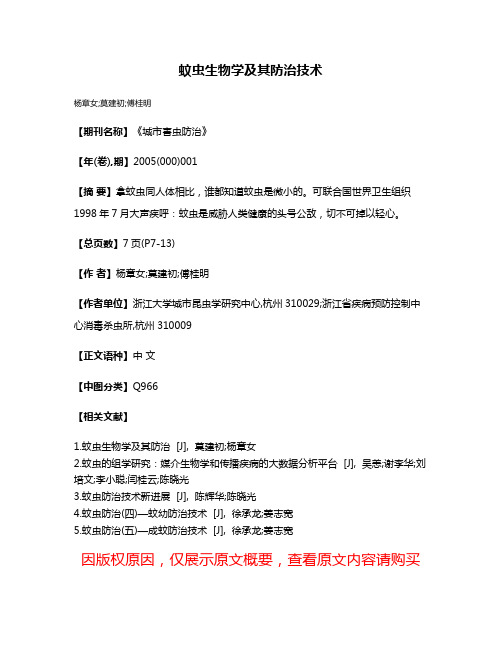
蚊虫生物学及其防治技术
杨章女;莫建初;傅桂明
【期刊名称】《城市害虫防治》
【年(卷),期】2005(000)001
【摘要】拿蚊虫同人体相比,谁都知道蚊虫是微小的。
可联合国世界卫生组织1998年7月大声疾呼:蚊虫是威胁人类健康的头号公敌,切不可掉以轻心。
【总页数】7页(P7-13)
【作者】杨章女;莫建初;傅桂明
【作者单位】浙江大学城市昆虫学研究中心,杭州310029;浙江省疾病预防控制中心消毒杀虫所,杭州310009
【正文语种】中文
【中图分类】Q966
【相关文献】
1.蚊虫生物学及其防治 [J], 莫建初;杨章女
2.蚊虫的组学研究:媒介生物学和传播疾病的大数据分析平台 [J], 吴恙;谢李华;刘培文;李小聪;闫桂云;陈晓光
3.蚊虫防治技术新进展 [J], 陈辉华;陈晓光
4.蚊虫防治(四)—蚊幼防治技术 [J], 徐承龙;姜志宽
5.蚊虫防治(五)—成蚊防治技术 [J], 徐承龙;姜志宽
因版权原因,仅展示原文概要,查看原文内容请购买。
声波驱蚊靠谱吗?
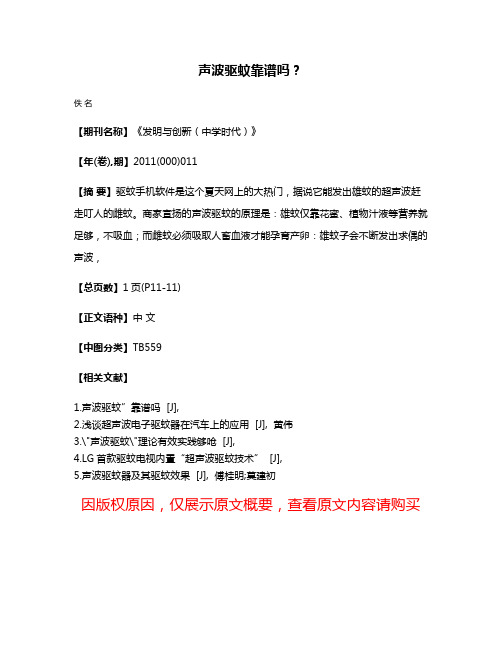
声波驱蚊靠谱吗?
佚名
【期刊名称】《发明与创新(中学时代)》
【年(卷),期】2011(000)011
【摘要】驱蚊手机软件是这个夏天网上的大热门,据说它能发出雄蚊的超声波赶走叮人的雌蚊。
商家宣扬的声波驱蚊的原理是:雄蚊仅靠花蜜、植物汁液等营养就足够,不吸血;而雌蚊必须吸取人畜血液才能孕育产卵:雄蚊子会不断发出求偶的声波,
【总页数】1页(P11-11)
【正文语种】中文
【中图分类】TB559
【相关文献】
1.声波驱蚊”靠谱吗 [J],
2.浅谈超声波电子驱蚊器在汽车上的应用 [J], 黄伟
3.\"声波驱蚊\"理论有效实践够呛 [J],
4.LG首款驱蚊电视内置“超声波驱蚊技术” [J],
5.声波驱蚊器及其驱蚊效果 [J], 傅桂明;莫建初
因版权原因,仅展示原文概要,查看原文内容请购买。
光诱捕技术在蚊媒传染病传播媒介防制中推广应用效益良好
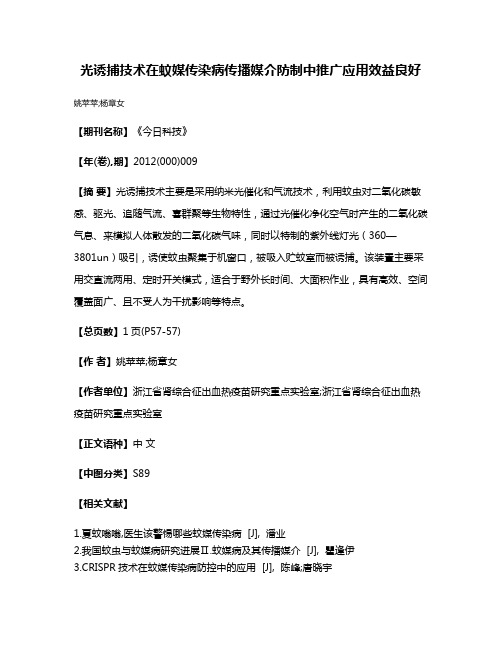
光诱捕技术在蚊媒传染病传播媒介防制中推广应用效益良好姚苹苹;杨章女
【期刊名称】《今日科技》
【年(卷),期】2012(000)009
【摘要】光诱捕技术主要是采用纳米光催化和气流技术,利用蚊虫对二氧化碳敏感、驱光、追随气流、喜群聚等生物特性,通过光催化净化空气时产生的二氧化碳气息、来模拟人体散发的二氧化碳气味,同时以特制的紫外线灯光(360—3801un)吸引,诱使蚊虫聚集于机窗口,被吸入贮蚊室而被诱捕。
该装置主要采用交直流两用、定时开关模式,适合于野外长时间、大面积作业,具有高效、空间覆盖面广、且不受人为干扰影响等特点。
【总页数】1页(P57-57)
【作者】姚苹苹;杨章女
【作者单位】浙江省肾综合征出血热疫苗研究重点实验室;浙江省肾综合征出血热疫苗研究重点实验室
【正文语种】中文
【中图分类】S89
【相关文献】
1.夏蚊嗡嗡,医生该警惕哪些蚊媒传染病 [J], 潘业
2.我国蚊虫与蚊媒病研究进展Ⅱ.蚊媒病及其传播媒介 [J], 瞿逢伊
3.CRISPR技术在蚊媒传染病防控中的应用 [J], 陈峰;唐晓宇
4.3S技术简介及在研究蚊及蚊媒传染病分布和控制中的应用 [J], 王晓东;赵彤言
5.GIS技术在蚊媒传染病监测中的应用与发展前景 [J], 杨天赐;傅桂明;任樟尧因版权原因,仅展示原文概要,查看原文内容请购买。
灯光诱杀害虫技术的发展与应用

灯光诱杀害虫技术的发展与应用
赵季秋
【期刊名称】《辽宁农业科学》
【年(卷),期】2012(000)001
【摘要】人类很早就知道"飞蛾扑火,自寻死路"这一自然现象,一般有翅类昆虫都有一定的趋光性,早在20世纪50年代人们就开始嚐试利用昆虫的趋光性的特点借助灯光诱杀害虫。
随着科学的不断发展,尤其是人们环保意识的不断提高,灯光诱杀害虫已经从无到有,不断向前发展,成为防治农林业害虫的一种重要手段,并且在不断发展与完善。
【总页数】2页(P67-68)
【作者】赵季秋
【作者单位】辽宁省昆虫学会,辽宁沈阳110161
【正文语种】中文
【中图分类】S475
【相关文献】
1.植物害虫灯光诱杀技术研究应用
2.害虫灯光诱杀技术在十堰市的推广应用
3.灯光诱杀技术在蔬菜害虫防控中的推广与应用
4.蔬菜害虫防治技术的发展与应用
5.灯光诱杀林木害虫技术研究
因版权原因,仅展示原文概要,查看原文内容请购买。
- 1、下载文档前请自行甄别文档内容的完整性,平台不提供额外的编辑、内容补充、找答案等附加服务。
- 2、"仅部分预览"的文档,不可在线预览部分如存在完整性等问题,可反馈申请退款(可完整预览的文档不适用该条件!)。
- 3、如文档侵犯您的权益,请联系客服反馈,我们会尽快为您处理(人工客服工作时间:9:00-18:30)。
蚊虫监测点宁波市地处浙江省沿海,地理位置和自然条件非常适合蚊虫的生长繁衍[1]。
为了加强对蚊虫的防制和减少传染病的发生,比较人工小时法和紫外灯诱捕法(灯诱法)的诱蚊效果,在宁波市部分地区开展了蚊虫季节消长调查,现将结果报告如下。
1材料与方法1.1材料“功夫小帅”诱蚊灯,武汉市吉星环保科技有限责任公司提供。
1.2调查方法1.2.1灯诱法在城区分别选择居民区、医院、公园、牲畜棚各4个和农舍3个,1-12月在室外悬挂1只诱蚊灯,开启时间18:00至次日6:00,将捕获的成蚊带回实验室分类鉴定并计数[2]。
1.2.2人工小时法在市中心城区选择2个居民区的3个单元,每月5、15、25日8:15-8:30,定人用电动吸蚊器捕捉栖息在一层自行车棚和过道内的成蚊15min,统计蚊虫密度(只/人工小时)[2]。
2结果2.1蚊虫监测情况2009年在宁波市共布放诱蚊灯2344只次,捕蚊34884只,蚊密度为1.24只/h。
密度高峰期为5-10月。
淡色库蚊(Culex pipiens pallens)和三带喙库蚊(Cx.tritaeniorhynchus)为优势种,分别占43.28%和52.59%(表1)。
在选择的各类生境中,居民区共布放诱蚊灯553只次,捕蚊3805只,蚊密度为0.58只/h,主要蚊种构成中,淡色库蚊占81.55%,其次是三带喙库蚊,占13.43%,中华按蚊(Anopheles sinensis)占2.31%,白纹伊蚊(Aedes albopictus)占1.97%。
公园的优势种为淡色文章编号:1003-4692(2010)04-0339-02【论著】光诱捕技术在蚊虫监测中的应用傅桂明1,白勇2,龚震宇1,徐荣2,邵国文2,林寅君3,孙继民1,朱光锋2【摘要】目的比较人工小时法和灯诱法的诱蚊效果,为科学规范开展蚊虫监测提供理论依据。
方法选择宁波市为试点,每月采用灯诱法调查成蚊,观察蚊类组成及季节变化情况,与2006-2008年人工小时法监测结果相比较。
结果2006-2008年居民区室内人工小时法监测,淡色库蚊为优势种,占捕蚊总数的99.17%,白纹伊蚊、中华按蚊、三带喙库蚊分别占0.49%、0.20%和0.13%。
居民区灯诱法监测,淡色库蚊占捕蚊总数的81.55%,三带喙库蚊、中华按蚊、白纹伊蚊分别占13.43%、2.31%和1.97%。
结论2种方法监测结果均能显示该地区优势蚊种构成情况,因而推广使用具有操作简单,人为影响因素小的灯诱法,认为其更适合长期系统监测。
【关键词】蚊虫;密度;监测方法中图分类号:R384.1文献标志码:AApplication of light traps in mosquito monitoring FU Gui⁃ming1,BAI Yong2,GONG Zhen⁃yu1,XU Rong2,SHAO Guo⁃wen2, LIN Yin⁃jun3,SUN Ji⁃min1,ZHU Guang⁃feng2.1Zhejiang Center for Disease Control and Prevention,Hangzhou310051,Zhejiang Province,China;2Ningbo Center for Disease Control and Prevention;3Jiangbei District Center for Disease Control and Prevention,Ningbo City Supported by the Medical and Health Care Projects Focus on Promoting Scientific and Technological Achievements(No.2007TG008)【Abstract】Objective To compare the effectiveness of the labor⁃hour method and the light trap method to mosquitoes, providing the basis for development of scientific and standard mosquito monitoring.Methods The study was conducted in Ningbo,where adult mosquitoes were monitored using the light trap method on a monthly basis to identify the composition and seasonal dynamics of mosquitoes.The resulting data were compared with the monitoring results from2006through2008based on the labor hour method.Results According to the labor⁃hour monitoring results,Culex pipiens pallens was the predominant indoor species in the residential areas of the city from2006to2008,accounting for99.17%of total mosquitoes.Aedes albopictus, Anopheles sinensis and Cx.tritaeniorhynchus accounted for0.49%,0.20%and0.13%,respectively.The light trap monitoring in residential areas showed that Cx.pipiens pallens accounted for81.55%of the total number,while Cx.tritaeniorhynchus,An.sinensis and Ae.albopictus accounted for13.43%,2.31%and1.97%,respectively.Conclusion Both kinds of approaches were useful in revealing the composition of predominant mosquito species in the region.Therefore,the light trap method,featuring ease of use and minimum man⁃made factors,is more suitable for long⁃term systematic monitoring.【Key words】Mosquitoes;Density;Monitoring基金项目:浙江省医药卫生科技成果重点推广项目(2007TG008)作者单位:1浙江省疾病预防控制中心病媒生物防制所(杭州310051);2宁波市疾病预防控制中心;3宁波市江北区疾病预防控制中心作者简介:傅桂明(1956-),男,主任技师,主要从事病媒生物与自然疫源性疾病的控制。
Email:guimingfu@库蚊,占76.05%;医院的优势种为淡色库蚊,占83.39%;农户的优势种为淡色库蚊,占57.49%,其次是三带喙库蚊,占38.08%;牲畜棚优势种为三带喙库蚊,占83.72%(表2)。
各类生境中以医院蚊虫密度最低,牲畜棚蚊密度最高。
淡色库蚊是该市城区、农村农舍的优势蚊种,三带喙库蚊是牲畜棚的优势蚊种,中华按蚊、白纹伊蚊的数量也较多。
2.2室内蚊虫种类构成2006-2008年采用人工小时法在室内共捕获成蚊7495只,分属3属4种,密度指数为69.40只/人工小时。
淡色库蚊为优势种,占99.17%,白纹伊蚊、中华按蚊、三带喙库蚊分别占0.49%、0.20%和0.13%[3]。
3讨论灯诱法和人工小时法调查结果显示,2种方法都能明确地监测到该市居民区蚊虫的构成情况,2009年宁波市居民区用灯诱法捕蚊,以淡色库蚊为优势种(81.55%);采用人工小时法,2006-2008年在室内监测,同样淡色库蚊为优势种,占99.17%。
由于城市中淡色库蚊孳生地众多,如生活污水、排水井、积水容器等,淡色库蚊属家栖蚊种。
三带喙库蚊居其次(13.43%),因该蚊种在城市下水道和积水容器孳生[4],它属于半家栖蚊种,室内人工小时法捕获数量比灯诱法要少。
农舍和牲畜棚周围多有稻田、莲藕、茭白等水生经济作物,三带喙库蚊密度比较高。
白纹伊蚊由于其栖息习性、吸血和活动时间与其它蚊种不完全相同[1],2种方法捕获数量均不高,不能反映出该蚊种的实际季节消长情况。
人工小时法和灯诱法主要用于成蚊监测,但由于监测地点和采集蚊虫的时间不同,两者在蚊虫密度上有很大的差别,没有可比性。
人工小时法使用干电池提供的电能,风扇产生的吸引力小,电池的电量大小与风扇的吸力有直接关系,对监测效果也有一定的影响;另外捕捉蚊虫时,需要监测人员手持吸蚊器,持续15min 。
该方法受人为因素影响较大,且费力、费时。
灯诱法的光源为紫外灯,监测时将灯挂在离地面1.5~2.0m 处,利用交流电使电风扇在光区的下方形成一定的负压捕获蚊虫,其吸力较大,弥补了人工小时监测方法吸力不足又不稳定的缺点。
自2005年浙江省病媒生物监测采用灯诱法试点,逐步替代人工小时法监测技术,2006年全省推广应用,由于灯诱法具有操作简单,使用范围广等优点,基层专业人员认为该方法适合长期系统监测。
目前全省在疾病控制系统蚊虫监测中应用灯诱法已达95%以上。
参考文献[1]白勇,邵国文,徐荣.宁波市流行性乙型脑炎媒介的调查与分析[J ].中国媒介生物学及控制杂志,2007,18(6):495-497.[2]汪诚信.有害生物治理[M ].北京:化学工业出版社,2005:687.[3]白勇,林寅君,徐荣.2006-2008年宁波市蚊虫季节消长调查与分析[J ].中国媒介生物学及控制杂志,2009,20(6):598-600.[4]李春晓,郭晓霞,黄恩炯.城市中三带喙库蚊孳生地的发现[J ].中国媒介生物学及控制杂志,2007,18(1):31.[收稿日期:2010-02-23]表12009年宁波市不同季节主要蚊种构成及密度Table 1Composition and density of major mosquito species in different seasons,Ningbo,2009月份123456789101112合计捕蚊只数7241603841753520413772609331113143108115234884密度(只/h )0.010.010.060.150.712.266.602.861.661.120.460.061.24淡色库蚊只数72313137913903612227120491651245699413315096构成(%)100.0095.8381.8898.7079.2969.4116.4933.6353.0778.1491.9587.5043.28三带喙库蚊只数0025229813081113237541251491751118347构成(%)0.000.0015.620.5217.0025.1380.8361.6140.2115.626.947.2452.59白纹伊蚊只数00404712519010410184120667构成(%)0.000.002.500.002.682.401.381.713.252.671.110.001.91中华按蚊只数00037122137170959808640构成(%)0.000.000.000.780.402.340.992.793.053.120.005.261.84其它只数010011374216131400134构成(%)0.004.170.000.000.630.710.300.260.420.450.000.000.38表22009年宁波市不同生境主要蚊种构成(%)Table 2Composition (%)of major mosquito species indifferent habitats,Ningbo,2009生境居民区公园医院农户牲畜棚布放诱蚊灯数(只)553498547502244捕蚊只数380552952703574917332淡色库蚊81.5576.0583.3957.4913.89三带喙库蚊13.4314.9812.6938.0883.72白纹伊蚊1.973.972.002.141.18中华按蚊2.313.781.442.051.13其它0.741.220.480.240.08。
